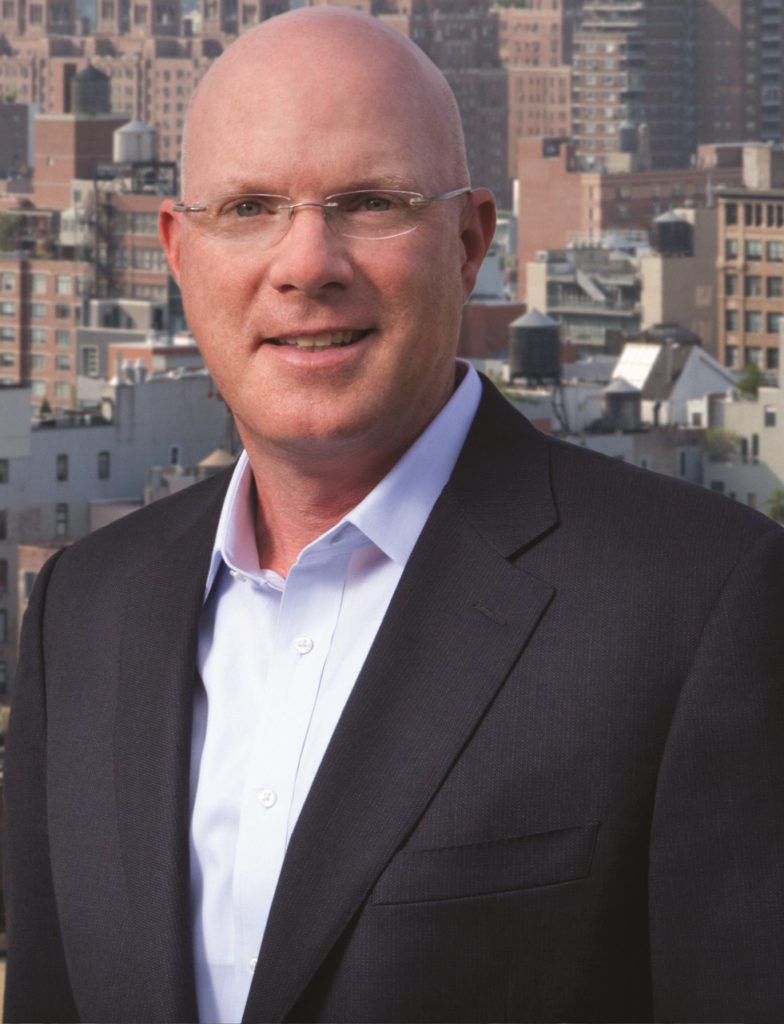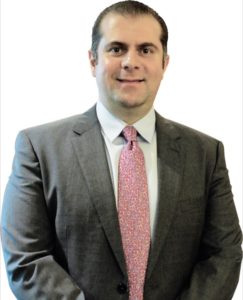And we are confident about the future, says John Mandyck, the Chief Sustainability Officer of United Technologies, on the company’s response to the developments at Kigali, as he in the company of Giorgio Elia, Vice President, Climate Control and Security (Middle East), United Technologies, and Mohammed Al Qaisi, General Manager at UTS Carrier, talks to B Surendar of Climate Control Middle East on a wide range of issues, including the company’s path-breaking initiative to quantify indoor environmental quality. Excerpts from the interview…
With HFCs coming under the purview of the Montreal Protocol in Kigali in 2016, what is UTC’s take on this? How do you see the world moving forward? And what would you be looking to offer to your customers in terms of leadership? Speaking to a lot of engineering directors, they seem to need more clarity, when it comes to chiller retrofits, though the deadlines are still some way off.

John Mandyck
John Mandyck: Carrier and United Technologies have been preparing for this for almost 10 years. The transition away from HFC refrigerants has been well known. The Montreal Protocol memo has been around for 6-8 years, and there has been activity in the EU – the F Gas regulation – that has predated Kigali. So we were preparing for this from a technology standpoint, from a transition standpoint and from an R&D standpoint. And we feel we are in a good position to meet the requirements, if not exceed the requirements. And this is in our DNA. We have done this well many times before. We led the industry in meeting the first Montreal Protocol requirements – the phase out of CFC refrigerants. We were the first to phase those out on a global basis, well ahead of domestic requirements. And then we led the world in the transition from HCFCs. We know how to do it.
This transition may be a little bit more difficult than the ones in the past, because we are running out of options in the periodic table of elements (laughs). There is nowhere else to go. But we are up for the challenge. We already have many alternatives in the market today, particularly in the food refrigeration space for either marine container refrigeration, supermarket refrigeration, or truck or trailer refrigeration. We are actually the only company in the world that is pursuing CO2 as a refrigerant across all of those platforms, which is ironic in the sense that CO2 is a greenhouse gas. But when operated under high pressure, it is very effective and it gets very, very cold, and food wants to be very, very cold. So we are pursuing that technology. In the HVAC space, we are pursuing HFO technology. We have several of those in pilot form. We feel good about those. So the technologies are on track, and we are confident about the future.
We see that when the charge size is very small, some of these flammable refrigerants can work well in hermetically sealed systems
Generally, how can we ensure safety, considering some of the HFOs have flammability characteristics?
Mandyck: Some among the new generation of refrigerants do have a flammability element. Propane is a very good refrigerant from an energy efficiency standpoint, but it is very, very flammable. It is being used today in Europe, for example, for very small domestic refrigerators. We see that when the charge size is very small, some of these flammable refrigerants can work well in hermetically sealed systems. But for large systems, propane is maybe not a good solution. So we are looking at HFOs, within which there is a broad range of flammability.
There are those that are more highly flammable than others. What we are looking at is a much lower end of the flammability scale. When you start to look at the periodic table of elements, and look at the options that you have, the blends, the chemicals to achieve the desired effect, what happens is that to get the low global warming potential (GWP) requirement that Kigali set out to achieve, you have to look at the range of the table that has flammability. So to do that, we are looking at ways where we can use the HFOs that have lower flammability.

Mohammed Al Qaisi
At one stage, will you be looking at HFOs for chillers in District Cooling applications?
Mohammed Al Qaisi: I cannot confirm that – it is still under engineering. But I can tell you that the next range of centrifugal chillers with more capacity will be running on HFOs.
Mandyck: It is a logical transition. You start with the smaller chillers and, then, scale it up. The timeframe here is that we have plenty of time from a compliance standpoint, particularly in the Middle East, which has a longer lead time. We are confident we are going to serve our customers and develop with the climate in mind.
Amidst all the talk on sustainable development, one of the aspects we don’t seem to be giving as much of consideration, as it perhaps deserves, is affordable cooling. How do we balance product development and associated costs and yet not give a price to customers that is beyond their reach?
Mandyck: These are issues we consider every day. When we look at the market regulations, we agree with the overall ends. We all support energy efficiency, we all support refrigerants that have lower global environmental impact. What we see is that in some cases, regulation doesn’t come for free, and innovation does not come for free. If you look at energy efficiency, the way machines become more energy efficient, in some cases we have to put more material into them. There’s more copper, there’s more steel, there’s more aluminium, so there’s more raw material costs for us. So that cost has to be passed on along the chain. If you look at the next transition of refrigerants that we are about to go through, there’s not only the research and development that is required but also the materials themselves are much more costly. The HFO compounds today are more costly than the HFC compounds. We don’t make them, we buy from suppliers. And so this is an issue that we have to balance, on how we can achieve the environmental aims of regulation, how we can achieve innovation but do it in a cost-effective way, so we can continue to serve our customers.
We also have to consider the savings that the person buying the product is going to make, with energy costs going down throughout the lifetime of the product
Quite tricky, though, isn’t it?
Al Qaisi: Yes, it is very difficult, but it is important to look at the total cost of ownership. It’s not just the initial price of the product; we also have to consider the savings that the person buying the product is going to make, with energy costs going down throughout the lifetime of the product. It is a balance of innovation, when we come up with a new technology that has higher efficiency, and of achieving a lower cost. Maybe the product is a little bit more expensive, but it will save a lot of money throughout the lifetime of the product.

Giorgio Elia
It’s like finding a sweet spot?
Giorgio Elia: Correct. It all depends on the customer’s knowledge. We need to sit down with the person concerned and tell him that if he buys a particular air conditioning equipment, he will have a savings and the return in three years. It is different than just selling the products and not explaining. The customer must be informed. Like any product, once you have a lot of innovation, lot of technologies, it is expensive at the time of launching. People will slowly start knowing about the benefits of the product. The economy of scale will kick in, and the cost of the product will go down, and it will become affordable.
Do you feel that will help you work on the barrier of a price-sensitive market, because most contractors are trying to base their buying decisions on cost?
Al Qaisi: We support and we are fully happy with the new regulations that the UAE is coming up with, because we will have quality products in the country. In the GCC region, they continue to improve their regulations. They are doing it step by step. They come up with high efficiency, and then they increase the bar. This is good, because now we are eliminating the products that are not efficient.
What is the update on your collaboration with Harvard University, where Dr Joe Allen has quantified IEQ and made a case for increasing fresh air intake to improve cognitive performance of the occupants, plus health. What has Carrier achieved through Dr Allen’s research?
Mandyck: Our objective with sponsoring the research at Harvard was to see if we could bring new data to the marketplace, so that people can make better decisions. People have been asking us for years, “Do Green Buildings improve productivity?” And that data didn’t exist. And that’s why we approached Harvard, three years ago, to ask if they could design research that studied that question. That led to landmark research, which was released in 2015, the CogFX Study 1, which found that the optimised indoor environmental quality often found in a Green Building improves cognitive test scores in that study by 101%, so that was an amazing find. And it started a whole new conversation in the real estate industry about the actual true value of a Green Building. Study 2, which involved 109 people in 10 office buildings across the United States, built on that. These were already high-performing buildings, so theoretically, they were already achieving the benefits of the maximum indoor environmental quality. So the question that Harvard set out to ask is, “Are there benefits even beyond that?” What they found is the answer was yes. These high-performing buildings – which were certified as Green Buildings – actually saw cognitive test scores that were 26% better. So that was on average, but in three particular areas, in crisis response score, the averages were 73%; for applied decision making, there was a 44% improvement; and for strategic decision making, there was a 31% improvement. So these are really powerful findings that we think will continue to change the conversation in the real estate industry on the true value of a Green Building. Today, or before the research, the value of a Green Building was really just measured on the basis of energy efficiency and water savings, and that’s really important, and we have to continue to do that, but this [the Harvard study] broadens the value proposition by including the productivity, which we think is very important.
How do you plan to replicate the Harvard study across the United States? How are you going to get buy-in from a building owner or a consultant, considering it takes a lot if effort to get everyone to read from the same page?
Mandyck: We are doing our best to make the research widely available. We are doing many customer briefings, whether it’s here in the Middle East or in New York City or Los Angeles. We are making sure that we bring the data to the marketplace. People are aware of it, and it’s working, because people are starting to think differently about how the building should operate, what the true benefits of the building can be.
[The writer is the Editor of Climate Control Middle East.]
Copyright © 2006-2025 - CPI Industry. All rights reserved.